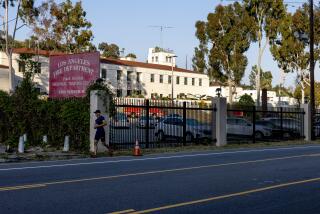Scientists Seek Clearer Airport Fog Predictions
- Share via
An experimental system for predicting when fog will lift could reduce flight delays at San Francisco International Airport and mean less time waiting on the ground in Los Angeles.
At least 70 mornings every summer, fog reduces the number of arrivals at the San Francisco airport from 55 to 30 every hour, forcing air traffic controllers to hold many flights at their originating airports until the fog lifts--which can be any time from 8 to 10:30 a.m.
In the past, controllers have not given permission for those flights to leave until the fog has actually lifted. Because the nearest major airports, such as LAX, are at least an hour away, that means about 25 landing slots are wasted during the first hour of sunlight--at a cost to airlines of about $200,000. The cost to travelers is missed meetings and great annoyance.
Airport officials hope that the new technology will allow them to forecast the lifting of the fog an hour in advance, thereby eliminating downtime. “The volume of traffic is so great that a difference in forecast of an hour or two has a huge significance,” said Walter Strach of the National Weather Service’s Oakland office, which provides weather forecasts for the San Francisco airport.
The findings do not apply to winter fog, which has different characteristics.
Problems with fog--technically called marine stratus and more commonly called a marine layer--are endemic along the West Coast, but represent a particular hazard in San Francisco, because of both the nearby bay and the design of the airport. San Francisco’s two main runways are only 750 feet apart, so they cannot be used simultaneously unless pilots can see clearly all around them.
When marine stratus is present, therefore, planes must land single file on only one runway.
Summer fog is created when moisture blowing in off the Pacific is trapped under an inversion layer. As it cools at night, it condenses and is held in place by the surrounding hills until it is burned off by the morning sun.
Since 1995, a team led by F. Wesley Wilson of Massachusetts Institute of Technology’s Lincoln Laboratory in Lexington, Mass., has been using special instruments to monitor the stratus, the intensity of sunlight and the direction and speed of winds around the airport.
A key technique has been the use of sonic detection and ranging (SODAR) instruments, which bounce sound waves off the inversion layer to determine the thickness of the stratus continuously. Previously, that thickness could be determined only by balloon flights, which were launched twice a day, and by reports from pilots. Neither provided any information about whether the stratus was stable or dissipating.
Another valuable piece of information has been provided by satellite photographs of the stratus, Wilson said. The team has found that changes in the brightness of the marine layer provide a good indication of how rapidly it is dissipating.
Working with researchers from San Jose State, Pennsylvania State University and the University of Quebec, Wilson has developed four formulas that combine the data in different ways to predict when the fog will lift.
The researchers compare those predictions with the actual times of dissipation to refine the formulas and determine which is best.
The team began providing predictions to the National Weather Service at the end of last summer and forecasters took them into account, but did not rely heavily on them. Both sides hope they will be more valuable next summer when the data are further refined.
The team’s goal is to predict the time of dissipation within 15 minutes. “We are not there yet,” Wilson said, “but we are within 20 to 25 minutes, which is a big improvement over the current status.”
Wilson cautioned that the formulas being developed are specific to San Francisco and cannot be used at other airports, although the techniques used in producing them could be applied elsewhere.
They also are not relevant for winter fog, which is, in effect, a horse of a different color. Winter fog is usually a byproduct of major storm systems off the coast and can persist for days at a time. That problem is being addressed by the installation of new radar systems.
Forecasting the end of a winter fog is also less crucial. “One hour [saved] is not as valuable at the end of a three-day event” as it is every morning, Wilson said.
More to Read
Sign up for Essential California
The most important California stories and recommendations in your inbox every morning.
You may occasionally receive promotional content from the Los Angeles Times.













